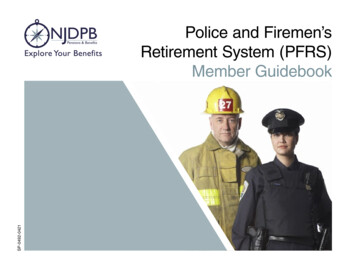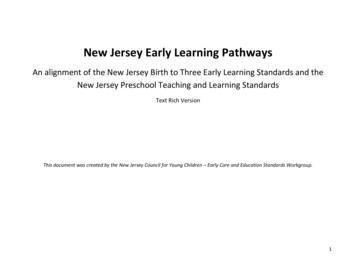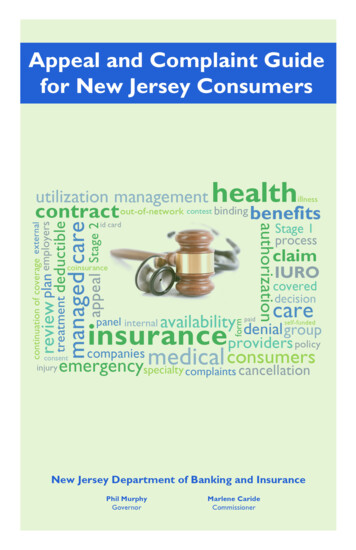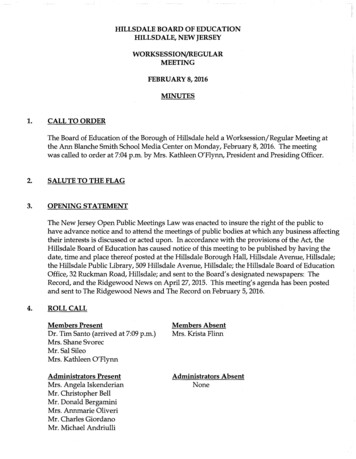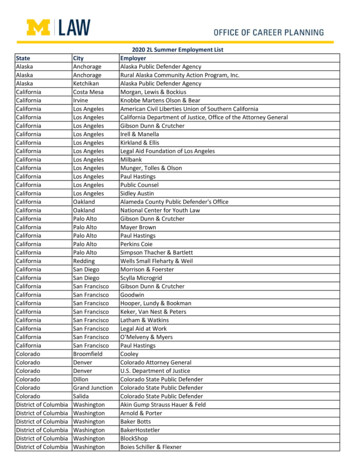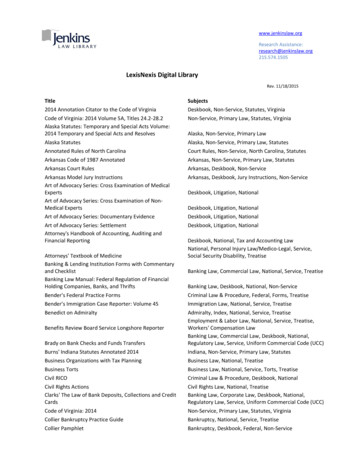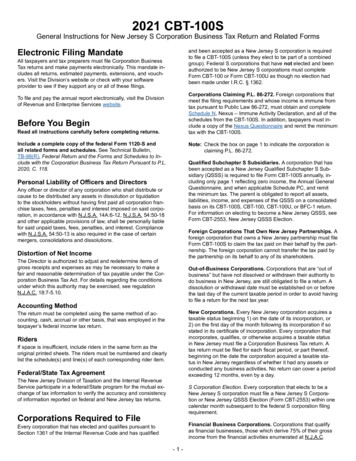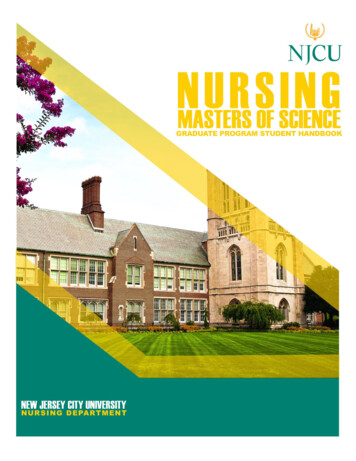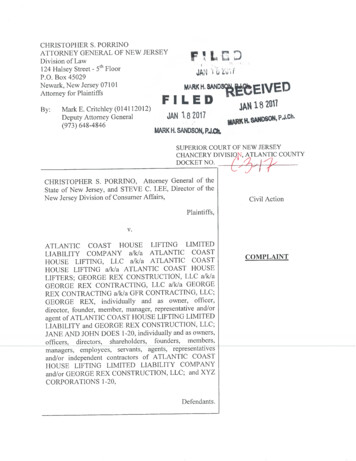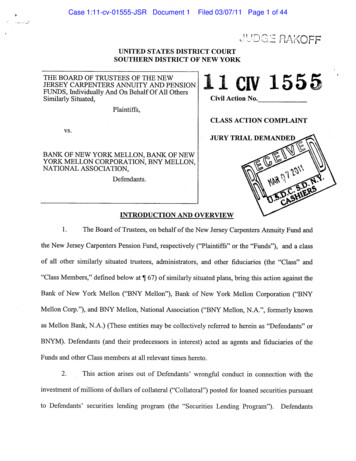
Transcription
New Jersey, New York, and Connecticut Sea Grant’sCall for Research ProposalsCoastal Storm Awareness Program (CSAP)Required Letter of Intent Due: 4:30 pm EDT Monday, October 28, 2013Full Proposals Due: 4:30 pm EST Friday, November 22, 2013Available funds: nearly 1.5 millionto support about 10 projects over a 16-month time spanJanuary 1, 2014, through April 30, 2015The objective of this research initiative, Sea Grant's Coastal Storm Awareness Program(CSAP), is to better understand the current mechanisms used to disseminate and receive coastalstorm hazard information, the information being conveyed (what, when, how, and by whom), thefactors that affect whether recipients of this information decide to act on it, and the actions thatthese recipients take as a result. The goal of the program is to save lives and promote publicsafety by providing valid social science research and/or technology-based tools that could beused by the National Weather Service, Emergency Managers, the media and coastal communitiesin order to ensure that informed decisions are made by coastal residents during severe coastalstorms. It is anticipated that the application of the funded research’s results will increase thelikelihood that residents who should remove themselves from harm’s way actually do so or takeother actions to prevent themselves from becoming storm casualties. Proposals funded underCSAP will focus on the coastal areas of New Jersey, New York and Connecticut impacted byHurricane Sandy.TABLE OF CONTENTSSection ISection IISection IIISection IVSection VSection VISection VIIBackgroundResearch Topics for this CallGeneral Information about Proposal SubmissionA. Who is Eligible to SubmitB. Duration of Proposed WorkC. Budget Size (IDC limited to 20%)D. Cost-Share Requirement (none)E. Data Management and Sharing PlanF. What and When to SubmitThe Review ProcessTimelineSea Grant ContactsSpecific Instructions for Full Proposal Components1Starting Page2236777
I. BACKGROUNDHurricane/Post-Tropical Cyclone Sandy made landfall on October 29, 2013, near Brigantine, NJ.From the Caribbean through the Eastern Seaboard of the United States, the storm caused massivedevastation of property and shorelines as well as loss of life. According to the National WeatherService (NWS) Assessment, 147 deaths were directly due to the storm. According to the Centerfor Disease Control, 40 of those were drowning deaths – deaths that might have been preventedif residents had evacuated. The scale of the storm and the populations it affected were verylarge. Sandy was the second most costly storm event in U.S. history, resulting in approximately 62 billion of economic losses.The National Sea Grant College Program awarded funds from the Sandy SupplementalAppropriations Legislation to the New Jersey, New York and Connecticut Sea Grant programsfor the purpose of funding research related to preventing these types of preventable deaths in thefuture. These Sea Grant programs will jointly administer and manage the Coastal StormsAwareness Program research competition and work with coastal stakeholders such as the NWS,emergency management agencies, media, and coastal communities through the CSAP ProgramSteering Committee. This Committee will ensure that research results will meet the needs of thestakeholders and increase the likelihood that results will be implemented at the appropriate localor regional level.II. RESEARCH TOPICS FOR THIS CALLThe Sea Grant Programs administering this Coastal Storm Awareness Program (CSAP) (NewJersey, New York and Connecticut) request proposals that contribute to or build upon priorsocial science research to better understand how and why people made or will make choicesrelative to coastal storm warnings or other high-impact weather events expected to affect coastalareas. The research could also develop guidelines, tools, and technologies that will assist thosewho are responsible for issuing or conveying storm information, and those who direct emergencymanagement efforts in communities to reduce casualties and losses.CSAP seeks proposals to enhance our understanding of how the risks from impending coastalstorms, and other high impact weather, are assessed, perceived, communicated, and acted upon(or not) in order to improve the delivery of information regarding coastal storms so as to protectpeople and save lives and property. Proposals that incorporate the development of technologyfor the purposes of risk communication are also encouraged.In responding to these needs, CSAP proposals may contribute to or build upon prior research toexplore:A. The nature of storm hazard information and warnings that communities and residents arereceiving.B. What sources and venues of information and warnings are trusted.C. The factors that determine how the public will or will not act on the informationprovided.Additional potential proposal topics could address, but are not limited to, the following:D. Development of technology-based information appropriate for communicating risks fromcoastal storms to emergency managers, the media and the public.2
E. Identifying cultural and language barriers that exist and effective ways that they can beovercome before and during a weather event.F. Testing of NOAA products used to convey risks (e.g., regarding wind in tropicalcyclones), similar to the testing of surge products which has already been completed andthe testing of watch/warning/advisory and the Hurricane Local Statement products whichis currently underway.G. Examining how social media is being used and how communicators can most effectivelyuse this tool during a weather emergency.NOAA is conducting a number of other activities and projects related to improvingcommunication and response efforts aimed at impending high impact weather and coastal stormhazards. More information on these activities is available here: http://www.nyseagrant.org/csapWork proposed for funding through CSAP should build upon or complement, but not duplicate,existing research including that conducted by or for NOAA or other relevant agencies, or addressan important aspect of coastal storm hazard communication and personal risk response that is notcovered by previous work. Letters of Intent (see below) should briefly mention how theproposed work will build upon or complement existing research and studies as well as anyspecific connections to entities involved in coastal storm communication and response.Qualifying projects include traditional social science disciplines such as anthropology,communications, economics, sociology, political science, psychology, as well asinterdisciplinary research addressing environmental policy, disaster management, datavisualization or human dimensions. Technology-based proposals should be embedded within theappropriate disciplinary perspective associated with the potential tool. CSAP encourages multidisciplinary and multi-investigator research to the extent that it is practical. In addition, projectswill be required to engage end-users (such as the NWS, emergency managers, and coastalcommunities) throughout the course of the project to ensure the relevance, utilization andsocietal impacts of the research outputs. For this Call, it is expected that Sea Grant Extensionprofessionals located in the Sandy-hit areas and the CSAP Program Steering Committee will beactively engaged in the research, through advising or other appropriate roles, to ensure that finalproducts are useful to end-users.III. GENERAL INFORMATION ABOUT PROPOSAL SUBMISSIONA. Who is Eligible to Submit:Eligible groups are listed below:1. Researchers at universities and colleges.2. Researchers at other not-for-profit or tribal research institutions.3. Researchers who are personnel of state or local agencies, or of not-for-profitorganizations.4. Researchers at for-profit institutions or companies (within limits established by theNational Sea Grant Office).Important Notes: Research must target coastal area(s) impacted by Hurricane/Post-TropicalCyclone Sandy in New Jersey, New York and Connecticut. To help NOAA, emergencymanagers, media and coastal communities to transition the results of these studies into their3
operations, preference will be given to proposals that include a component that can be tested in aNOAA weather facility or other appropriate venues for the research proposed. Federalemployees may participate in projects as collaborators, but are not eligible to receive funds underthis initiative, and their contributions cannot be considered a source of cost-sharing. Studentscan be involved in the research projects, but cannot serve as Principal, co-Principal, or AssociateInvestigators. Personnel that have an employment affiliation with the Sea Grant programs in NJ,NY, or CT are not eligible for funding under this Call.B. Duration of Proposed Work:In this Call, the research projects will run for a maximum of 16 months during the period January2, 2014, through April 30, 2015. There will be no possibility for any type of extension due tothe source of the funds.C. Budget Size (total of indirect plus direct costs):The total budget request (direct indirect costs) for a project may not exceed 150,000 for the16-month period. Budgets must include travel costs for 2 trips to the NY/NJ area for meetingswith the CSAP Program Steering Committee, during month 5 of the project and at the end of theproject. Final payments will not be made until final reports are filed. Indirect cost rates asnormally levied on budget categories by the recipient institution are limited to 20% of therequested funds in those categories.D. Cost-Share Requirement:CSAP has no cost-share requirement.E. Data Management and Sharing Plan:New NOAA regulations require that data and information collected and/or created under NOAA(including Sea Grant) grants must be made visible, accessible, and independently understandableto general users, free of charge or at minimal cost, in a timely manner (typically no later than twoyears after the data are collected or created), except where limited by law, regulation, policy orby security requirements.The new requirement has two basic parts: (1) environmental and socio-economic data generatedby a grant project must be made available after a reasonable period of exclusive use, and (2) thegrant proposal must describe the plan to make the data available.To comply with this new requirement, the principal investigator must include a data managementplan within their proposal that describes how and when the project’s data and metadata will bemade available to others. Deposition of data in standard data archives (e.g., by discipline) or inavailable university archives is encouraged. This requirement for data archiving is in addition tothe expected publication of research results in peer-reviewed journals. The proposed plan will bereviewed for compliance with NOAA requirements.F. What and When to Submit:1. Letter of IntentIn order for a full proposal to be considered, a Letter of Intent (LOI) must be submitted by 4:30pm EDT on Monday October 28, 2013. It must be submitted electronically through New York4
Sea Grant’s electronic submission web site: www.NYSGProposal.org . On that site, navigate to“Coastal Storm Awareness Program (CSAP)” and follow all directions for electronic submission.Be sure to include the following information in the Letter of Intent: The names, affiliations and contact information of the personnel expected to be involved; A draft title; and A brief statement, not to exceed two pages, describing the question or issue you plan toaddress in a full proposal.Important notes about LOI submission:a) Signatures of principal investigators or campus officials are not required.b) Submit it as a single pdf file, with 1” margins all around, and a font equivalent to 12point New Times Roman.c) We recommend submission via a PC at your university office, with a current version ofInternet Explorer, Firefox, or Google Chrome web browser installed.d) If you have trouble with submission through www.NYSGProposal.org, call NYSG (631632-9780) to explain the problem. We will try to help, but cannot guarantee that we cansolve your problem. In any case, unless the web site (housed on the Stony BrookUniversity server) becomes inoperable, it is your responsibility to use equipment thatwill allow you to meet the deadline.e) Submissions received after the deadline of 4:30 pm EDT on October 28, 2013, cannot beaccepted and the lead investigator will be notified. Please be sure to watch the time!Even if you are on the website before the deadline, if your file is not submitted by 4:30pm, it will not be accepted.f) A LOI reference number will be provided to the lead author.g) The LOI will not be used as a screening tool. Since there is no pre-proposal step, theLOI will be helpful to the managers of CSAP to prepare for full proposal review.h) No full proposal will be accepted without a Letter of Intent filed prior to the deadline.2. Full ProposalFull proposals must be submitted by 4:30 pm EST on Friday November 22, 2014. Like theLOIs, they must be submitted electronically through New York Sea Grant’s electronicsubmission web site: www.NYSGProposal.org . Navigate to “Coastal Storm AwarenessProgram (CSAP)” and follow all directions for electronic submission.The full proposals must follow the Instructions in Section VII, which starts on page 8.Important notes about full proposal submission:a) Only proposals for which a Letter of Intent had been received will be considered. Besure to indicate in a cover note the LOI reference number that had been provided to thelead author.b) Submissions that do not include the required information (see Section VII forInstructions) will lose rating points.c) Double-check your proposal file before uploading it at the submission web site to makesure it is PC-readable and that it is your final version. It must be in the form of a single5
d)e)f)g)pdf file. You will receive an auto-receipt from the web site confirming your submission,but this is not an indication that your file is readable.We recommend submission via a PC at your university office, with a current version ofInternet Explorer, Firefox, or Google Chrome web browser installed.If you have trouble with submission through www.NYSGProposal.org, call NYSG (631632-9780) to explain the problem. We will try to help, but cannot guarantee that we cansolve your problem. In any case, unless the web site (housed on the Stony BrookUniversity server) becomes inoperable, it is your responsibility to use equipment that willallow you to meet the deadline.All submissions will be checked in the order they were posted and any that contain avirus or that are unreadable cannot be accepted. The lead investigator will be notifiedabout this by email. However, for submissions that are posted on November 22, NYSGcannot guarantee that this check and notification will take place before the 4:30 pm ESTdeadline.Submissions received after the deadline of 4:30 pm EST on November 22, 2013, will notbe accepted and the lead investigator will be notified. Please be sure to watch the time!Even if you are on the website before the deadline, if your file is not submitted by 4:30pm EST, it will not be accepted.IV. THE REVIEW PROCESSAll proposals submitted in response to this CSAP call will be screened by the CSAP Sea Grantprograms’ managers and appropriate extension staff, aided by a composite Proposal ReviewPanel, comprised of a subset of the CSAP Program Steering Committee members and a numberof invited technical experts. The CSAP Program Steering Committee is comprised ofrepresentatives from the NWS, emergency hazard response community, and publiccommunications media in the Sandy-affected areas.Projects will be selected on the basis of the following criteria: Significance of the specific problem or issue in the context of the CSAP goals andresearch topics – the degree to which the proposed project reflects the goals and researchtopics of the Call, and addresses a significant problem or issue.Scientific or technical merit of the work plan – the degree to which the research activityuses appropriate hypotheses and methods.Expected products and anticipated impacts – efficacy, significance and importance of theproducts (models, methods, tools, and scientific information) and impacts (change inbehavior/policies) that are expected to result from this project; usability of the products anddocumentable impacts.Qualifications of the investigators – the degree to which investigators are qualified byeducation, training, and/or experience to execute the proposed activity.Appropriateness of the budget – the degree to which the requested funding is appropriateand reflects reasonable costs for the proposed research.Data Management/Sharing Plan – this section will be provided to, but not evaluated by theProposal Review Panel. Rather, once the top proposals are selected, Sea Grant staff willassess whether the Plan is satisfactory.6
V. TIMELINEOctober 10, 2013October 28, 2013November 22, 2013December 19, 2013January 2, 2014April 30, 2015June 1, 2015CSAP Call for Proposals releasedDeadline for Letter of intent at 4:30 pm EDTDeadline for full proposals at 4:30 pm ESTCSAP Sea Grant programs notify successful investigatorsResearch projects’ earliest start dateResearch projects’ latest end dateDeadline for Final Reports at 4:30 PM EDTVI. SEA GRANT CONTACTSNew Jersey Sea GrantPeter Rowe, Associate Director (732-872-1300 x31), prowe@njseagrant.orgNew York Sea GrantWilliam Wise, Interim Director (631-632-6905), william.wise@stonybrook.eduConnecticut Sea GrantSylvain De Guise, Director (860-405-9138), sylvain.deguise@uconn.eduVII. SPECIFIC INSTRUCTIONS FOR FULL PROPOSAL COMPONENTS(use as a checklist)Be sure to use the format and provide the information as described below. Components A-Kand all of the information specified within them is required. Use all-around margins of atleast 1” and a font size no less than #12 Times New Roman. Submissions that do not include allof the required information and/or that do not follow the format requirements will lose ratingpoints and/or be truncated.A. Title Page: See example and downloadable blank versions of this on NYSG’s webpage olicies-downloadable-forms-forproposal-submission. Be sure to include pages for subcontracting institutions (follow examples).Obtain all required signatures and scan all title pages as one PDF document in order to submitelectronically.B. Project Summary Form 90-2: See example and use downloadable blankversions of this from NYSG’s web page licies-downloadable-forms-for-proposal-submission. The Project Summary Form should verybriefly convey all essential elements of the proposed activities. It may not exceed 1-2 pages inlength.C. Project Narrative: Organize your materials for Sections 1-6 as presented below,and follow the examples and guidelines provided. This component (C, with its 6 sections) maynot exceed 12 pages, including any figures, tables, etc. Pages beyond this limit will be removed.7
1. PROJECT TITLE:The title should be brief, specific, and descriptive of the activity.2. PRINCIPAL AND ASSOCIATE INVESTIGATORS:List principal, co-principal, and associate investigators with department and university/institutionaffiliations. Students cannot be PIs or AIs, do not list them here.3. INTRODUCTION / BACKGROUND / JUSTIFICATION:Text in this section should explain why/how the proposed research is important. You shouldcarefully review other significant, related work and demonstrate how your proposed researchwill build on this base. Finally, be sure to clearly describe how this project will significantlycontribute to achieving the goals and addressing the research topics of this Call.4. GENERAL WORK PLAN AND MILESTONES:Clearly and succinctly state your project hypotheses. Then list the objectives of your project(which should be the same as listed in the 90-2 form). Describe the overall study design andwork plan and outline in detail the research methods, techniques, and analytical/statisticalmethods (as appropriate) that will be used to accomplish the stated objectives. Spell out whatyou expect to accomplish and in what time frame, identifying specific milestones. Be sure toinclude: the steps and techniques that will be used; the experimental design; any data sources to be used and how they will be accessed; and any facility and equipment requirements and how they will be met.Reviewers should be able to assess the appropriateness of the proposed work plan and milestonesfor achieving the stated project objectives.5. OUTCOMES:One of the National Sea Grant Office’s main emphases is that Sea Grant activities, includingresearch, must be able to show documentable accomplishments and impacts. It is very importantthat the full proposal describe how the project results would be used and by whom. How do youplan to convey the results and what demonstrable impacts would come from this? In otherwords, this section should detail the significance and importance of the products and impacts thatare expected to result from the proposed project. You should also describe the usability of theproducts (e.g., who will be able to use them, how will they have access, etc.) and how theimpacts can be documented (e.g., how will one be able to measure the impacts to accrue fromyour results). Your statements should be specific and, optimally, should be substantiated byreferences or attached supportive correspondence.6. COORDINATION:List the roles and responsibilities of personnel, including students, as related to the project.Letters that verify the collaboration of other investigators or organizations to be involved withthe project (if any) must be included in your proposal submission. Also, please note that closecoordination of your research with the agency, industry, or other user group that will be its primebeneficiary is a good way to enhance the success of your project. This section should clearlyshow that you have already investigated these connections and contacts. We recommend that8
you contact Sea Grant in the areas in which you will be conducting research about this becausethey are likely to be involved with the extension of your results, as well. In addition, they shouldbe able to connect you with appropriate members of the CSAP Program Steering Committee. Ifyour work will be carried out in conjunction with a business, industry, government organizationor citizen's group, list the name and address of the organization and the main contact person. Ifthe group is providing financial support, data, materials, manpower or guidance, be sure to statethis and provide correspondence that verifies the commitment. In this section, you should alsodescribe any linkages that the project would have with other programs or projects: international,federal, state, or local. Describe how this proposal is complementary, not duplicative.D. Data Management/Sharing Plan (not to exceed 2 pages)New NOAA regulations require that data and information collected and/or created under NOAA(including Sea Grant) grants must be made visible, accessible, and independently understandableto general users, free of charge or at minimal cost, in a timely manner (typically no later than twoyears after the data are collected or created), except where limited by law, regulation, policy orby security requirements. The new requirement has two basic parts: (1) environmental andsocio-economic data generated by a grant project must be made available after a reasonableperiod of exclusive use, and (2) the grant proposal must describe the plan to make the dataavailable.To comply with this new requirement, your full proposal must include a data management/sharing plan that describes how the project’s data and metadata will be made available to others.Deposition of data in standard data archives (e.g., by discipline) or in available university orNOAA archives is encouraged. This requirement for data archiving is in addition to the expectedpublication of research results in peer-reviewed journals. The proposed plan will be reviewed forcompliance with NOAA requirements. If funds are needed for this task, they must be included inthe full proposal budget form and text justification.Per NOAA, “environmental data” are recorded and derived observations and measurements ofthe physical, chemical, biological, geological, and geophysical properties and conditions of theoceans, atmosphere, space environment, sun, and solid earth, as well as correlative data, such associo-economic data, related documentation, and metadata. Media, including voice recordingsand photographs, may be included.Per NOAA, “independently understandable” means that the data must be accompanied withdocumentation, metadata and, if needed, tools to read the data that allow the user to interpret thedata properly. If there are concerns by users with data access or understandability, they can bereported to NOAA, who will do an independent check.There are several acceptable ways to share data, but the CSAP Sea Grant programs stronglyprefer that you use either:a) Data Archive – a place where data are acquired, manipulated, documented, anddistributed. NOAA facilities that archive data and make the data openly available shouldbe considered. Disciplinary databases and university archives are also options.b) Data Enclave – a controlled, secure environment in which eligible researchers canperform analyses using data resources.9
A typical plan should include a description of the types of environmental data and informationcreated during the course of the project; the tentative date by which data will be shared; thestandards to be used for data / metadata format and content; policies addressing data stewardshipand preservation; procedures for providing access, sharing, and security (including location); andprior experience in publishing such data.A few other points: If the project will not generate environmental data, it is sufficient (and necessary) to statethat in a sentence. The CSAP Sea Grant programs do not have the capacity to serve as a repository, but ifyou need information about potential archives or enclaves, contact the Sea Grantpersonnel listed in the Call’s section VI, above. This section of your proposal will be included in the materials read by the Review Panel,but will not be evaluated by them. Sea Grant staff will assess whether the plan seemssatisfactory, but NOAA will have the final word on whether the proposed plan meetstheir minimum requirements. It will be the CSAP Sea Grant programs’ responsibility to ensure and enforce that youfollow the proposed and accepted plan. Be sure the Data Management/Sharing Plan does not exceed 2 pages.E. Literature Cited: Include the complete citations for each publication referencedwithin the proposal. If none, state that.F. Project Timeline: See example and use downloadable blank versions of thetimeline form on the web page G. Budget Justification: This must be a written narrative. The dollar figure andjustification for each budget category will be closely examined, so PIs must be very careful toexplain all anticipated expenses. Please remember that matching funds (aka cost share) are notrequired under this Call. Also please remember that under this special Call, indirect cost ratesas normally levied on budget categories by the recipient institution are limited to 20% ofthe requested funds in those categories.To assist with your submission, please use New York Sea Grant’s generic “fiscal policies”website, which contains guidance information and should answer many questions you may haveas you prepare your budget. The website is licies-forms-policies and includes guidelines regarding allowable budgetary items. on for an example budget justification. Note that the special conditions about matchingfunds and indirect costs are not highlighted in these generic policies, although they do apply tothe CSAP Call.H. Subcontract Scope of Work and Budget Justification: Include for eachsubcontracting institution, if any.10
I. Budget Forms 90-4: Be sure to include a budget form for the lead institution andeach subcontract. Again, see oliciesdownloadable-forms-for-proposal-submission for an example and downloadable blank versions.If you have questions, please use the Sea Grant contacts listed in Section VI.J. Biosketch: Include only for all Principal, co-Principal, and Associate Investigators,not to exceed 2 pages each. Do not include vitae for students or other personnel.K. Other Research Support: For each principal, co-principal, and associateinvestigator, list all current active support and all applications/proposals pending review orfunding. Include source of support, months committed to the project, dates of duration, annualdirect costs, project title, any overlap with the present proposal. If none, state that.L. Letters of Collaboration, Support, and Cost-Share Commitment: Ifappropriate, include correspondence regarding expected impacts and benefits, collaborativeefforts and/or others' support for the project, and/or letters certifying match commitment (if any).Scan hard copies of such materials or have them sent to you by email so that you can includethem as part of your electronic submission. Faxes, emails, and hard copies will not beaccepted.11
New Jersey, New York, and Connecticut Sea Grant's Call for Research Proposals Coastal Storm Awareness Program (CSAP) Required Letter of Intent Due: 4:30 pm EDT Monday, October 28, 2013 Full Proposals Due: 4:30 pm EST Friday, November 22, 2013 Available funds: nearly 1.5 million to support about 10 projects over a 16-month time span
